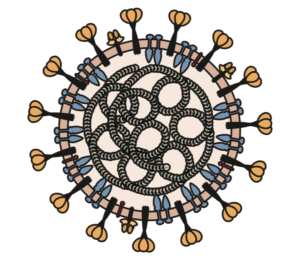

Rich Condit is a virologist and emeritus Professor, University of Florida, Gainesville and a host on This Week in Virology.
Modeling done by the Institute for Health Metrics and Evaluation (IHME) at the University of Washington suggests that if stringent social distancing measures are kept in place, the €œfirst wave€ of covid-19 disease in the US may subside by mid-June, with a total accumulation of ~93,000 deaths. The IHME states that: €œBy end the of the first wave of the epidemic, an estimated 97% of the population of the United States will still be susceptible to the disease, so avoiding reintroduction of COVID-19 through mass screening, contact tracing, and quarantine will be essential to avoid a second wave.
I find it more than a little unnerving that after a grueling €œfirst wave€ of disease, a mere 3% of the population may be infected and thus be (at least relatively) immune to re-infection. I seriously doubt if after the first wave the virus will be €œgone€, rather just beaten back but nevertheless broadly if thinly distributed throughout the population and poised for a comeback when social distancing restrictions are lifted. If at that time, 97% of the population remains uninfected, then we are destined for a very significant second wave of infection.
But is that 3% infection ratio accurate, and if not, what is the real number? To understand this, we need to understand the difference between case fatality rate (CFR) and infection fatality rate (IFR). CFR is the ratio of the number of deaths divided by the number of confirmed (preferably by nucleic acid testing) cases of disease. IFR is the ratio of deaths divided by the number of actual infections with SARS-CoV-2. Because nucleic acid testing is limited and currently available primarily to people with significant indications of and risk factors for covid-19 disease, and because a large number of infections with SARS-CoV-2 result in mild or even asymptomatic disease, the IFR is likely to be significantly lower than the CFR. The Centre for Evidence-Based Medicine (CEBM) at the University of Oxford currently estimates the CFR globally at 0.51%, with all the caveats pertaining thereto. CEBM estimates the IFR at 0.1% to 0.26%, with even more caveats pertaining thereto.
Crunching some numbers, if IHME estimates 3% of the US population (~330M) resistant to the disease after the first wave, that implies 9.9M infections. The IHME prediction of ~93,000 deaths implies an IFR of 0.9%, close to the commonly estimated 1% CFR globally. Note that IHME is really only projecting deaths based on real data, and therefore should not be faulted for choosing a conservative estimate of infection rate (~1%), especially given that the IFR is, at this point in time, a particularly slippery number. However, if, just for argument’s sake, the IFR is really as low as 0.1%, then it follows that after the first wave of disease, as much as 30% of the US population will have been infected and thus resistant to reinfection. It seems to me that this would give the virus considerably less fertile ground to grow on and significantly dampen the impact of a second wave.
This is not just an intellectual exercise. Understanding the true infection fatality rate has major consequences for planning control measures following our first encounter with SARS-CoV-2.
We can and should obtain a direct measure of the SARS-CoV-2 IFR to help plan for the future of the pandemic. Simple and relatively inexpensive kits have become available which test for antibodies to SARS-CoV-2 in a drop of blood in a few minutes. These kits adapt existing technology developed for other pathogens to SARS-CoV-2. The kits allow for €œpoint-of-care€ testing, that is, they can be used anywhere and results are obtained in real time, and they require only minimal instruction for use. (An example of how such a kit works can be found here. The FDA has given Emergency Use Authorization to Cellex, Inc. for use of their kit. Dozens of other companies and laboratories are developing similar tests.) The kits test for both IgM and IgG antibodies specific for SARS-CoV-2 in the blood. IgM is the first antibody to appear after an infection, usually within about one to two weeks. Within about three weeks IgM disappears and is gradually replaced with IgG. Therefore, the kit can determine whether a test subject has ever been infected with SARS-CoV-2, and if so, whether that infection was recent.
If I were king, I would distribute SARS-CoV-2 test kits free of charge to pharmacies nation-wide, and consider setting up testing stations at commonly frequented locations such as schools, sporting events, polling stations, and yes, even bars. I would also establish a centralized, web based database for collecting and collating the test results. The data collected could be used to determine exactly the IFR in the US, along with a geographic distribution and possibly other demographic information.
We were asleep at the switch for the first wave. Let’s wake up and catch the second wave.
http://covid19.healthdata.org/
https://www.cebm.net/covid-19/global-covid-19-case-fatality-rates/

Comments are closed.